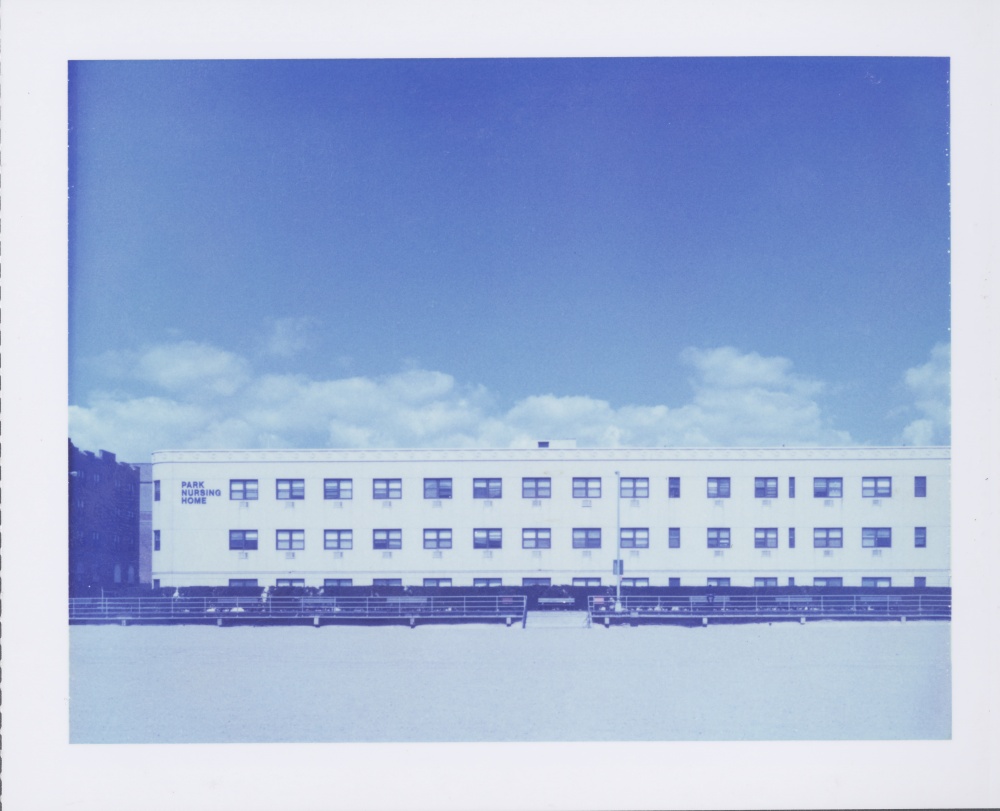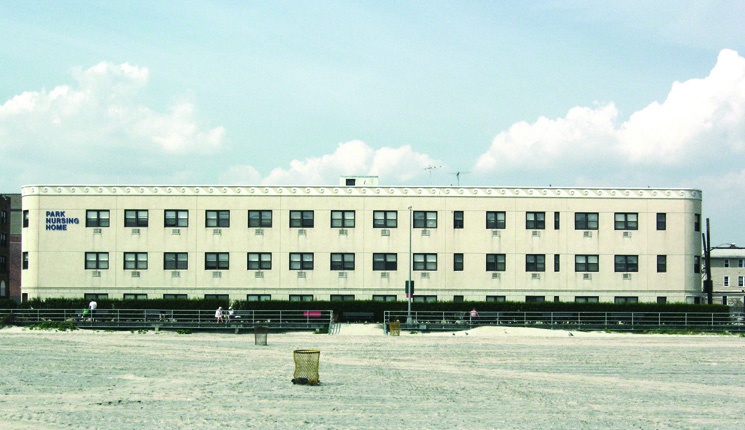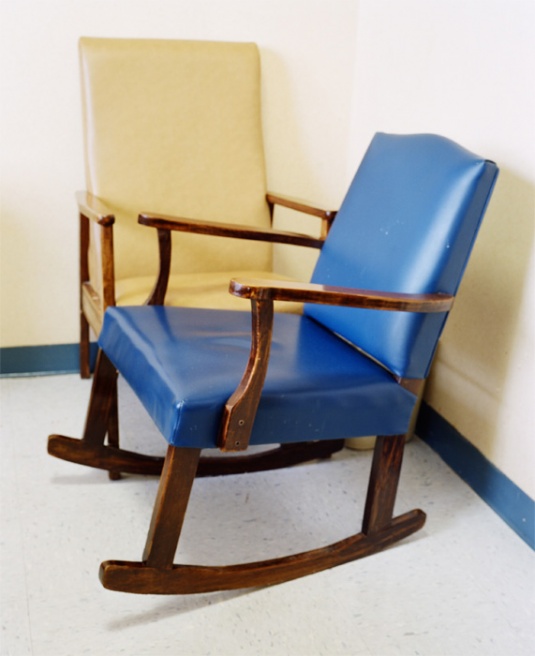The first pictures I made of the Park Nursing Home were color Polaroids that came from an expired box. the colors on the exposed Polaroids were unpredictable, even with a proper exposure, and produced a saturated blue color. I was working on a series of beachfront facades that overlooked the landscape of Far rockaway’s beaches, and had decided to use Polaroids to get a visual idea of the composition. Park Nursing Home(P.N.H.) became an important reference for me. I found myself returning to the image again and again. My attraction to the banal plays an important role in my process of finding photographic opportunities. The nursing home interested me mainly because of its large scale. The off-white building was comprised of three floors, 54 evenly-spaced windows overlooking the beach's sands, and it appeared to be close to the length of a football field.
I regard most architectural structures as very powerful because the activities that take place within occur in the spirit of unifying and establishing an exchange of company and community. From this examination, I made the first series of photographic documents that would address my desire to look deeper at this architectural record. I moved to set up the field camera in the sand, directly in front of the building at a distance that would make it technically possible to include the entire stretch of this panorama, subsequently transforming the horizon into the institution.
Why did I return time after time to this place? When i received the contacts of the first images I made at the Park Nursing Home, I listened to several of the observations that were made about the oddness of how this nursing home looked; how the nautical pattern detailing the roofline made the place feel as if some kind of healing, fun or leisure was intended. From the outside of the Park Nursing Home, one could easily see a resemblance to a hospital. interestingly as well was the large scale of property it covered, and its use: a home for people who no longer can live in a home.
I thought, what a strange concept. Weeks later, I had a more intimate conversation with my girlfriend about the moral questions of whether or not I would want my family members—in particular my mother and father to spend their last days and nights in a nursing home. I decided that I would contact the administration and request all access permission to photograph the interior.
In the beginning of my routine visits to P.N.H., I was tempted to photograph people in the space. I imagined a series of portraits of staff members who assisted the residents with continuing their lives under care. I did not follow through with this as my initial idea of photographing interiors became more and more interesting. I saw there was potential in trying to translate the sense of loneliness, and the long and tiresome atmosphere. I felt the idea of loss in a metaphorical sense, would be evident by my conscious decision to remove people from the photographs.
As a result of making over one hundred images at P.N.H., and editing down a cohesive body, I would like to briefly examine the balance of formalism and chance that occurred frequently in the process of making this series. I noticed several things upon entering the rooms of P.N.H.— the placement of furniture, the use of art and the personalization of the rooms by the residents. In one hallway, there was a dresser with a potted plant on top. The dresser was placed against the railing just off the wall. On the same wall, above the dresser hung a picture frame and a large mirror. a sense of displacement resonated within me, inspired by the residents living in a home away from home, and by objects that seemed foreign to a domestic setting.
This sensation was overwhelming throughout my visits to P.N.H. In almost every room I entered, and walkway I passed through, there was a framed piece of artwork fastened securely to the wall, and in most cases, there were very visible screws that penetrated the frame itself. in viewing the framed pieces, one cannot escape the irony evoked by the permanence of the décor and to the transitoriness of the residents. I then noticed the desire of the residents to make their space personal, using fragments from the outside world such as a baseball cap, a rosary, small-framed pictures, stuffed animals, posters and candleholders.
I found it unnecessary to disturb an already uncomfortable scene. it was more important to capture the essence of the place by keying in on particular areas that included objects, or an implied absence of the traces of a life. Some of the photographs draw on formal photographic strategies using dramatic geometry, long exposures, consistent distance of the focal plain, and a language evoked from the color palette.
Chance occurs in a number of photographs by introducing a softer focus with hand-held exposures in low light situations. a dramatic shift occurs when fine details are apparent. The viewer is directed to examine the institution's attempts at creating comfort, and the repetition of tropes of confinement and isolation. In the photograph (p.n.h. 19), the camera presents the viewer with two worlds. the use of light and dark turns into a play on positive and negative space, and offers two metaphorical choices: Life or death. The contrast between a cluster of yellow and orange daisies out of water, resting on a windowsill, gives a glimpse onto the hopes of an enjoyable life, yet the inevitability of wilting or death, looms.
Equally important to me, is to acknowledge the trauma felt in the air of P.N.H. in the photograph (p.n.h. 46), we see examples of several instances where the idea of domestic space is signified. In the background there is a framed painting. It hangs above a non-operative stove/oven and sink. It is a water-colored painting of a window that is open on gold hinges. Outside the window is a seascape that includes palm trees, walkways, a lighthouse, and Spanish-style architecture; including white textured walls and brown clay-like roof tiling. The contrast between this imagined scene and the P.N.H. scene that is captured in the photograph underscores how coping with a trauma depends on the actual psychology of the space we inhabit post-trauma. In the center of the room is a round table cluttered with different colored objects intended for rehabilitating the residents. The objects in their awkward arrangement give the impression of an assortment of toys left behind by a child. Moreover, the photograph offers a view beneath the table. We see a mechanism that allows the table to rise and fall. The mechanism looks like it was appropriated from a barber shop.
“Remember empathy” – Nayland Blake. The anticipation of distress, sadness and surrealism within the walls of this institution interested me. This series of images explores the convergence between domestic and institutional spaces. In one nursing home, I was struck by the efforts that have been made to make it feel less like an institution, but how ultimately the institutional and the personal coexist.The residents are intentionally not included in the photographs to evoke feelings of absence, time, comfort, discomfort and confinement. In each photograph, I aimed to tell a narrative by balancing the twin demands of comfort and efficiency. The photographs question failures within the institution. Without disturbing the scene, I looked to make images that represent the intimate and familiar interactions that occur within these spaces, yet are contradicted by the oppressiveness of the institutional setting.
A clinical smell pervaded the air at P.N.H. It forced me to endure the same conditions that the residents faced. I was a young and healthy visitor with the privilege to come and go as i pleased. the residents ‘belonged’ to the community inside P.N.H. I then would come to revisit again and again, acknowledging prior observations and building them with new observations.
Lenard Smith
Photographer
Park Nursing Home
Public Story
Park Nursing Home
























